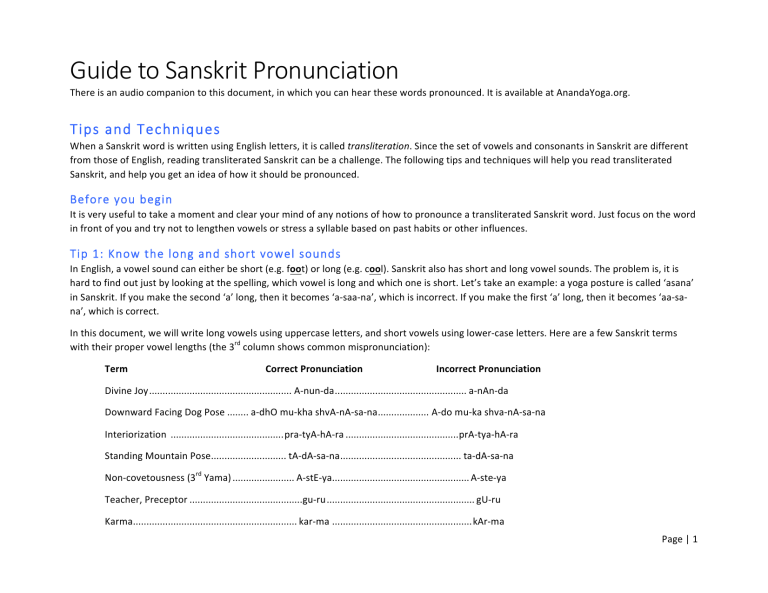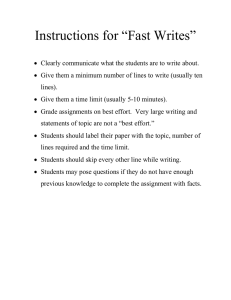
Guide to Sanskrit Pronunciation There is an audio companion to this document, in which you can hear these words pronounced. It is available at AnandaYoga.org. Tips and Techniques When a Sanskrit word is written using English letters, it is called transliteration. Since the set of vowels and consonants in Sanskrit are different from those of English, reading transliterated Sanskrit can be a challenge. The following tips and techniques will help you read transliterated Sanskrit, and help you get an idea of how it should be pronounced. Before you begin It is very useful to take a moment and clear your mind of any notions of how to pronounce a transliterated Sanskrit word. Just focus on the word in front of you and try not to lengthen vowels or stress a syllable based on past habits or other influences. Tip 1: Know the long and short vowel sounds In English, a vowel sound can either be short (e.g. foot) or long (e.g. cool). Sanskrit also has short and long vowel sounds. The problem is, it is hard to find out just by looking at the spelling, which vowel is long and which one is short. Let’s take an example: a yoga posture is called ‘asana’ in Sanskrit. If you make the second ‘a’ long, then it becomes ‘a-­‐saa-­‐na’, which is incorrect. If you make the first ‘a’ long, then it becomes ‘aa-­‐sa-­‐ na’, which is correct. In this document, we will write long vowels using uppercase letters, and short vowels using lower-­‐case letters. Here are a few Sanskrit terms with their proper vowel lengths (the 3rd column shows common mispronunciation): Term Correct Pronunciation Incorrect Pronunciation Divine Joy ..................................................... A-­‐nun-­‐da ................................................. a-­‐nAn-­‐da Downward Facing Dog Pose ........ a-­‐dhO mu-­‐kha shvA-­‐nA-­‐sa-­‐na ................... A-­‐do mu-­‐ka shva-­‐nA-­‐sa-­‐na Interiorization .......................................... pra-­‐tyA-­‐hA-­‐ra .......................................... prA-­‐tya-­‐hA-­‐ra Standing Mountain Pose ............................ tA-­‐dA-­‐sa-­‐na ............................................. ta-­‐dA-­‐sa-­‐na Non-­‐covetousness (3rd Yama) ....................... A-­‐stE-­‐ya ................................................... A-­‐ste-­‐ya Teacher, Preceptor .......................................... gu-­‐ru ....................................................... gU-­‐ru Karma ............................................................. kar-­‐ma .................................................... kAr-­‐ma Page | 1 How do you find which vowels are long and which ones are short when looking at a name? Generally speaking, this is tricky. If you are an Ananda Yoga Teacher, your manual tells you, for each asana, the long and the short vowels in the name. This document gives that information for many common Sanskrit terms, asanas, and pranayamas. (Sanskrit doesn’t really have a long and a short ‘o’. However, when it is pronounced, the ‘o’ is usually medium long, like in the word ‘yoga’. To bring out this quality, I have written it as if it were a long ‘O’) Tip 2: Know which consonants are aspirated In English, some consonants can be aspirated. To see what aspiration is, say the word ‘ten’ and the word ‘stun’. ‘t’ is aspirated when you say ‘ten’ – there is a puff of air that accompanies the end of the consonant. If you had a candle in front of you and said ‘ten’, the flame would flicker as a result of the aspirated ‘t’. In ‘stun’, the ‘t’ sound flows smoothly, without any interruption – it is un-­‐aspirated. Most consonants in Sanskrit have aspirated and un-­‐aspirated variations. Here are a few terms with aspirated consonants in them (which are underlined): Cobra Pose ................................. bhu-­‐jun-­‐gA-­‐sa-­‐na Perfect Pose ............................... si-­‐ddhA-­‐sa-­‐na Root, or Coccyx Center ............. mU-­‐lA-­‐dhA-­‐ra Absorption ................................ sa-­‐mA-­‐dhi It is easy to find out the aspirated consonant in when looking at the spelling – they have an ‘h’ after the letter to indicate aspiration. For example, the ‘h’ following the ‘b’ in ‘Bhujangasana’ indicates aspiration on the ‘b’. Tip 3: Know how to say your s’s The letter ‘s’ is pronounced one way in ‘sip’ and another way in ‘shout’. These are called sibilants. Sanskrit also has sibilants; sometimes one makes the ‘ssss’ sound when saying an ‘s’; other times one makes the ‘shhh’ sound. Sibilants are a complex topic; purists will insist on several variations. But in practice, these variations are too nuanced to be heard easily. In the interest of simplicity, we will talk about two variations: the ‘ssss’ sound like ‘sip’, and the ‘shhh’ sound like ‘shout’. Here are some Sanskrit terms with the ‘ssss’ sound: Shoulderstand ........................... sar-­‐vAn-­‐gA-­‐sa-­‐na Page | 2 Perfect Pose .............................. si-­‐ddhA-­‐sa-­‐na Truthfulness .............................. sa-­‐tya Crown Center ............................ sa-­‐ha-­‐srA-­‐ra Here are some terms with the ‘shhh’ sound: Corpse Pose .............................. sha-­‐vA-­‐sa-­‐na Camel Pose ............................... ush-­‐trA-­‐sa-­‐na Throat, or Cervical Center ......... vi-­‐shu-­‐ddha Purity ........................................ shou-­‐cha To make things more fun, here are some terms that have both variations in them: Vasishtha’s Pose ....................... va-­‐si-­‐shthA-­‐sa-­‐na Sacral Center ............................. swa-­‐dhi-­‐shtA-­‐na Contentment ............................. san-­‐tO-­‐sha How to find out which ‘s’s are ‘ssss’ and which ones are ‘shhh’? Some transliterations put an ‘h’ next to the ‘s’ to make this clear; so, if you see an ‘sh’, then you should pronounce it with ‘shhh’. However, you cannot rely on it; Corpse Pose is frequently spelled as ‘Savasana’ even though the first ‘s’ is the ‘shhh’ sound. This document has explicitly called out the sibilant to use for common Sanskrit terms and asana names. Other Suggestions As is the case with most subjects, 20% of the information takes you 80% of the way. The 3 tips above are this 20%, and should take you a long way in supercharging your Sanskrit. In a tutorial of this nature, it is not possible to capture all the nuances of Sanskrit pronunciation. However, if you are feeling a bit more intrepid, here’re a few more suggestions which will fine-­‐tune your Sanskrit. Mind your ‘c’s The word ‘chakra’ is often pronounced as ‘shA-­‐kra’. This is because the ‘ch’ signals to us to make the ‘shA’ sound (a sibilant!). It is more accurate however, to pronounce the ‘ch’ like you would in the word ‘chart’. Therefore, ‘chakra’ is pronounced as ‘cha-­‐kra’ Page | 3 Roll your ‘r’s It is generally a good idea to roll your ‘r’s when saying Sanskrit words. Again, to take the example of ‘chakra’, try gently rolling the ‘r’ when you say it. For more practice, try ‘bha-­‐stri-­‐ka’ (the Bellows Breath). Don’t over-­‐roll, like ‘cha-­‐krrra’ or ‘bha-­‐strrri-­‐ka’ – that will add a harsh quality to the word; instead, just be aware of the need to roll the ‘r’ as you say the word. Dropped ‘a’s You will often hear people drop the final ‘a’ in many words. For example, ‘asana’ becomes ‘asan’, ‘pranayama’ becomes ‘pranayam’ and even ‘yoga’ becomes ‘yog’. This has to do with the differences among various regional pronunciations in India. In some regions, the trailing ‘a’ is dropped while saying a word and in other regions, it is not. In Sanskrit itself, the last ‘a’ is always articulated as a short vowel. Conjunct Consonants The 7th limb of Ashtanga Yoga is Dhyana – Meditation. It is pronounced as ‘dhyA-­‐na’. The first syllable is an example of a ‘conjunct consonant’ – two consonants yoked together with no vowel in between. Some conjunct consonants are easy to say, e.g. ‘ma-­‐tsya’ (fish) and ‘pa-­‐dma’ (lotus). But others, like dhyA-­‐na, are hard. There is a temptation to insert a vowel in between, like ‘dhi-­‐yA-­‐na’. Learning to say the conjuncts without the vowel will improve your Sanskrit pronunciation greatly. Another one to practice is ‘swA-­‐dhyA-­‐ya. Differing Asana Names One final thing that is of relevance in this context: what to do when you encounter two different names for a yoga posture, or the same name referring to two different yoga postures? While most asana names are common among yoga lineages, there are some differences. For example, the Wheel pose is called Chakrasana by some, and Urdhva Dhanurasana by others. Each name gives an accurate, evocative, visual description of the pose. Chakra means wheel; it is easy to see why the pose resembles a wheel. Urdhva Dhanus means upward facing bow. Again, you can see how this is evocative of the spinal extension in this pose. Sometimes, different poses have the same name. Ardha Chandrasana – Half Moon Pose – is used to indicate a standing sideways bend by some; others use the name to indicate a balancing triangle pose. So which one is the “official” name? Neither, or both, depending on how you look at it! The name of a posture reflects the specific intuition and attunement of that teacher. The tradition of yoga, which has been transmitted by teacher to student, is based on intuition and experience; it doesn’t lend itself well to a rigid scheme of classification and rules. Instead of debating about the correct name, it is much better to practice the pose so that you can feel the truth of all names through direct experience. Page | 4 Pronunciation Reference In the tables below, a pronunciation guide is given for each Sanskrit term. The following conventions are used: 1. Long vowels are written in upper-­‐case, e.g. ‘A’. Short vowels are written in lower-­‐case, e.g. ‘a’ 2. The letter ‘h’ after a consonant is used to indicate aspiration, except in the case of ‘s’ and ‘c’ 3. ‘c’ is like the ‘c’ in ‘cat’; ‘ch’ is like ‘chart’; ‘s’ is like ‘sip’; ‘sh’ is like ‘shout’ Asana Names Sanskrit Pronunciation English Notes Ananda A-­‐nun-­‐da Divine Joy, Bliss Asana A-­‐sa-­‐na Posture Commonly mispronounced as ‘a-­‐sA-­‐na’ Hatha ha-­‐tha Forceful The aspirated ‘t’ makes this forceful! ‘ha’ means sun, ‘tha’ means moon. So Hatha Yoga also means the practice which balances the sun and moon aspects Adho Mukha Shvanasana a-­‐dhO mu-­‐kha shvA-­‐ nA-­‐sa-­‐na Downward-­‐Facing Dog Pose ‘Shvana’ means dog; don’t confuse it with ‘Shava’, which means corpse. Akarshana Dhanurasana A-­‐kar-­‐sha-­‐na dha-­‐nu-­‐ rA-­‐sa-­‐na Pulling-­‐the-­‐Bow Pose Ardha Chandrasana ar-­‐dha chan-­‐drA-­‐sa-­‐na Half Moon Pose The first ‘a’ in both words is short. Also, the ‘c’ is like ‘chart’, not like ‘shout’. Ardha Matsyendrasana ar-­‐dha ma-­‐tsyEn-­‐drA-­‐ sa-­‐na Half Spinal Twist The first ‘a’ is short. Baddha Konasana ba-­‐ddha kO-­‐nA-­‐sa-­‐na Bound Angle Pose (also Butterfly Pose) ‘Kona’ means ‘angle. You will see this as part of several other asana names Bakasana ba-­‐kA-­‐sa-­‐na Crane Pose Balasana bA-­‐lA-­‐sa-­‐na Child Pose This is commonly pronounced with a short first ‘a’. In Sanskrit, ‘ba-­‐la’ means strength, while ‘bA-­‐la’ means child. A short first ‘a’ makes it ‘Strength Pose instead of ‘Child’s Pose’! Bhujangasana bhu-­‐jun-­‐gA-­‐sa-­‐na Cobra Pose The aspiration on the first syllable will make your Sanskrit very authentic ‘Ardha’ means ‘half’. You will see it in other asana names Page | 5 Chakrasana cha-­‐krA-­‐sa-­‐na Circle Pose (also Wheel Pose Rolling the ‘r’ a little bit gives it a good ‘Sanskrit quality’. Also, the ‘c’ is like ‘chart’, not like ‘shout’ Dhanurasana dha-­‐nu-­‐rA-­‐sa-­‐na Bow Pose Ganapatiasana ga-­‐na-­‐pa-­‐ti-­‐A-­‐sa-­‐na Ganapati’s (Ganesha’s) Pose ‘Ganas’ refers to the retinue of Shiva; ‘pati’ and ‘isha’ both mean ‘Lord of’. Thus ‘Ganapati’ and ‘Ganesha’ both mean ‘Lord of (Shiva’s) Hosts’ Garudasana ga-­‐ru-­‐dA-­‐sa-­‐na Eagle Pose (also Twisted Pose) Gomukhasana gO-­‐mu-­‐khA-­‐sa-­‐na Face of Light Pose Halasana ha-­‐lA-­‐sa-­‐na Plow Pose Janushirasana jA-­‐nu-­‐shi-­‐rA-­‐sa-­‐na Head-­‐to-­‐the-­‐Knee Pose Jathara Parivartanasana ja-­‐tha-­‐ra pa-­‐ri-­‐var-­‐ta-­‐ nA-­‐sa-­‐na Supine Twist The aspirated ‘t’ in the first word and the rolled ‘r’s give this name a good ‘Sanskrit quality’ Karnapirasana kar-­‐na-­‐pI-­‐dA-­‐sa-­‐na Ear-­‐Closing Pose Matsyasana ma-­‐tsyA-­‐sa-­‐na Fish Pose Muktasana muk-­‐tA-­‐sa-­‐na Freedom Pose Natarajasana na-­‐ta-­‐rA-­‐jA-­‐sa-­‐na Dancing Shiva Pose (also King-­‐of-­‐the-­‐Dance Pose) Notice ‘raja’ in the middle of this name—the same as ‘raja’ in ‘Raja Yoga’, ‘Raja Kapotasana’, etc. In all cases, the meaning is ‘royal’ or ‘king’ Navasana na-­‐vA-­‐sa-­‐na Boat Pose Stress the ‘v’ as if it were German or Dutch Padahastasana pA-­‐da-­‐ha-­‐stA-­‐sa-­‐na Jackknife Pose (also Hand-­‐to-­‐Foot Pose, Standing Forward Bend) Padmasana pa-­‐dmA-­‐sa-­‐na Lotus Pose Parighasana pa-­‐ri-­‐ghA-­‐sa-­‐na Gate Pose Parsvakonasana pA-­‐rshva-­‐kO-­‐nA-­‐sa-­‐na Side Angle Pose Parvatasana pa-­‐rva-­‐tA-­‐sa-­‐na Seated Mountain Pose Parsvotanasana pAr-­‐shvO-­‐ttAnA-­‐sa-­‐na Side Stretching Pose (also Many long vowels – say it long and see how it is a metaphor for the Pyramid pose) stretch in the pose. The first ‘s’ is pronounced like ‘shout’ Page | 6 Paschimotanasana pa-­‐shchi-­‐mO-­‐ttA-­‐nA-­‐sa-­‐ na Posterior Stretching Pose The first ‘s’ is pronounced like ‘shout’ Pavanamuktasana pa-­‐va-­‐na-­‐mu-­‐ktA-­‐sa-­‐na Wind-­‐Freeing Pose Pincha Mayurasana pin-­‐cha ma-­‐yU-­‐rA-­‐sa-­‐na Peacock Feather Pose ‘ch’ doesn’t indicate aspiration; rather, it is a clue to pronounce it like ‘chart’, not ‘cart’ Prasarita Padotanasana pra-­‐sA-­‐ri-­‐ta pA-­‐dO-­‐ttA-­‐ nA-­‐sa-­‐na Wide-­‐Stance Forward Bend ‘uttana’ means an intense, or deep, stretch. This appears in several asanas in this list. Can you find them all? (Hint: there are four) Purvotanasana pU-­‐rvO-­‐ttA-­‐nA-­‐sa-­‐na Front-­‐Stretching Pose Notice how all the ‘uttana’ poses have many long vowels. Deep stretch, anyone? Rajakapotasana rA-­‐ja ka-­‐pO-­‐tA-­‐sa-­‐na Royal Pigeon Pose Salabhasana sha-­‐la-­‐bhA-­‐sa-­‐na Locust Pose The first ‘s’ pronounced like ‘shout’ Sarvangasana sar-­‐vAn-­‐gA-­‐sa-­‐na Shoulderstand Sasamgasana sa-­‐sAm-­‐gA-­‐sa-­‐na Hare Pose Savasana sha-­‐vA-­‐sa-­‐na Corpse Pose The first ‘s’ pronounced like ‘shout’ Setu Bandhasana se-­‐tu ban-­‐dhA-­‐sa-­‐na Bridge Pose Siddhasana si-­‐ddhA-­‐sa-­‐na Perfect Pose Simhasana sim-­‐hA-­‐sa-­‐na Lion Pose It is important to articulate the ‘h’ as you say it. Don’t glide over it, like ‘simmasana’. Sirshasana shi-­‐rshA-­‐sa-­‐na Headstand Supta Vajrasana sU-­‐pta-­‐va-­‐jrA-­‐sa-­‐na Supine Firm Pose ‘supta’ means supine. Like ‘parshva’ (side) and ‘ardha’ (half), it is used to prefix asana names Surya Namaskar sUr-­‐ya na-­‐ma-­‐skA-­‐ra Sun Salutations Tadasana tA-­‐dA-­‐sa-­‐na Standing Mountain Pose Notice the long first and second ‘a’. If you make only the second ‘a’ long, you get the common mispronunciation: tadAsana Tola Trikonasana tO-­‐la tri-­‐kO-­‐nA-­‐sa-­‐na Balancing Triangle Pose ‘kona’ means angle. Like ‘raja’ and ‘uttana’, it is present in many asana names. Can you find other asanas in this list which have ‘kona’ in them? (Hint: there are four) Note the appearance of ‘mukta’ in this word. This is the same as what appears in ‘muktasana’, and it means ‘Freedom’ Page | 7 Trikonasana tri-­‐kO-­‐nA-­‐sa-­‐na Triangle Pose Commonly mis-­‐pronounced with a short ‘o’. Upavistha Konasana upa-­‐vi-­‐sh-­‐ta kO-­‐nA-­‐sa-­‐ na Seated Angle Pose The first ‘s’ is pronounced like ‘shout’ Ustrasana ush-­‐trA-­‐sa-­‐na Camel Pose The first ‘s’ is pronounced like ‘shout’ Utkatasana u-­‐tka-­‐tA-­‐sa-­‐na Chair Pose Vajrasana va-­‐jrA-­‐sa-­‐na Firm Pose (also Thunderbolt Pose, Diamond Pose) Vasishthasana va-­‐si-­‐shthA-­‐sa-­‐na Vasishtha’s Pose Viparita Karani vi-­‐pa-­‐rI-­‐ta ka-­‐ra-­‐ni Simple Inverted Pose Virabhadrasana vI-­‐ra—bha-­‐drA-­‐sa-­‐na Warrior Pose The aspiration of ‘bha’ at the center of this word adds a lot of power to the name. Vrikasana vri-­‐kA-­‐sa-­‐na Tree Pose Yoga Mudra yO-­‐ga mu-­‐dra Symbol of Yoga Pranayama Names Sanskrit Pronunciation English Notes Pranayama prA-­‐nA-­‐yA-­‐ma Energy Control Commonly translated as Breath Control. Notice the long ‘a’s Bhastrika bha-­‐stri-­‐ka Bellows Breath The first ‘a’ is short! Chandra Bheda chun-­‐dra bhE-­‐da Lunar Breath Dirgha dIrgha The ‘I’ is long. ‘Dirgha’ literally means long; so when you say this with a long ‘I’, it expresses the intent of the pranayama very well Kapalabhati ka-­‐pa-­‐la-­‐bhA-­‐ti Breath of fire Nadi Shodhanam nA-­‐di shO-­‐dha-­‐nam Alternate Nostril Breathing ‘nadi’s are the channels through which energy flows Sitali si-­‐tA-­‐li Cooling Breath Sitakari si-­‐ta-­‐kA-­‐ri Hissing Breath Page | 8 Surya Bheda sUr-­‐ya bhE-­‐da Solar Breath The word ‘bheda’ (pierce), like the words ‘bandha’ (lock) and ‘baddha’ (bound), has a certain quality which is best expressed by aspiration Ujjayi u-­‐jjA-­‐yi Victorious There is a tendency to lengthen the ‘u’ and blend the last two syllables, to produce a sound like U-­‐jai; try instead to keep the ‘u’ short, and articulate the last two syllables separately Other Common Sanskrit Terms Sanskrit Pronunciation English Notes Ananda A-­‐nun-­‐da Divine Joy, Bliss Asana A-­‐sa-­‐na Posture Commonly mispronounced as ‘a-­‐sA-­‐na’ Chakra cha-­‐kra Wheel Rolling the ‘r’ a little bit. Also, the ‘c’ is like ‘chart’, not like ‘shout’ Guru gu-­‐ru Teacher, Preceptor Commonly mispronounced as ‘gU-­‐ru’ Karma kar-­‐ma Karma Commonly mispronounced as kAr-­‐ma Muladhara mU-­‐lA-­‐dhA-­‐ra Root, or Coccyx Center Sometimes spelt as mooladhara; the ‘oo’ indicates a long ‘u’ sound. Swadhistana swa-­‐dhi-­‐shtA-­‐na Sacral Center The first ‘s’ is like ‘sip’ and the second ‘s’ is like ‘shout’ Manipura ma-­‐ni-­‐pu-­‐ra Lumbar Center Anahata a-­‐nA-­‐ha-­‐ta Heart Center Note where the long ‘a’ is! Vishuddha vi-­‐shu-­‐ddha Throat, or Cervical Center Aspirating the ‘d’ gives this a good ‘Sanskrit quality’ Agya a-­‐gya Spiritual Eye The ‘gya’ sound is hard to transliterate. After the ‘g’, there is a slight nasal sound which quickly moves to the ‘y’, like it was ‘g-­‐nya’. You will see this written, rather opaquely, as ‘jna’. Sahasrara sa-­‐ha-­‐srA-­‐ra Crown Center Don’t over-­‐roll your ‘r’s on this. Page | 9 Ashtanga ash-­‐tAn-­‐ga 8-­‐limbs or 8-­‐parts. Usually part of the phrase ‘Ashtanga Yoga’, the 8-­‐Limbed Yoga The first syllable rhymes with the English word hush Yama ya-­‐ma The Controls Both the ‘a’s should be short. Commonly mispronounced as ‘yA-­‐ma’ Niyama ni-­‐ya-­‐ma The Observances Both the ‘a’s should be short. Commonly mispronounced as ‘ni-­‐yA-­‐ma’ Pranayama prA-­‐nA-­‐yA-­‐ma Energy Control Commonly translated as Breath Control. Notice the long ‘a’s Pratyahara pra-­‐tyA-­‐hA-­‐ra Interiorization Dharana dhA-­‐ra-­‐na Concentration Dhyana dhyA-­‐na Meditation The first syllable is a ‘conjunct consonant’. Avoid the temptation to insert a vowel in between, like ‘dhi-­‐yA-­‐na’. Samadhi sa-­‐mA-­‐dhi Oneness Commonly mispronounced by dropping the aspiration on ‘d’ Ahimsa a-­‐him-­‐sa Harmlessness Satya sa-­‐tya Truthfulness Commonly mispronounced as ‘sA-­‐tcha’ Asteya A-­‐stE-­‐ya Non-­‐covetousness Note that both the ‘a’ and the ‘e’ are long Brahmacharya bra-­‐hma-­‐cha-­‐rya Continence Aparigraha a-­‐pa-­‐ri-­‐gra-­‐ha Non-­‐attachment Shoucha shou-­‐cha Purity Santosha san-­‐tO-­‐sha Contentment Tapasya ta-­‐pa-­‐sya Austerity Commonly mis-­‐pronounced as ‘ta-­‐pA-­‐sya’ Swadhyaya swA-­‐dhyA-­‐ya Introspection Second syllable is a conjunct consonant. Beware of the tendency to drop the ‘y’ Page | 10 Ishwara Pranidana I-­‐shwa-­‐ra prA-­‐ni-­‐dA-­‐na Devotional surrender to God; openness to higher truths A long, but essentially simple set of words. A good one to practice your vowel-­‐length techniques on. Page | 11

